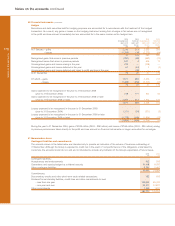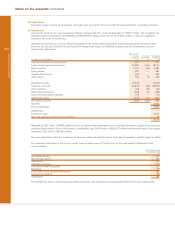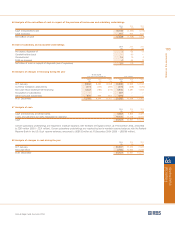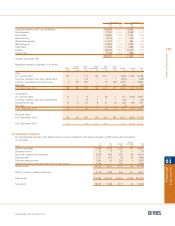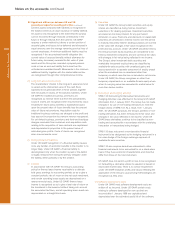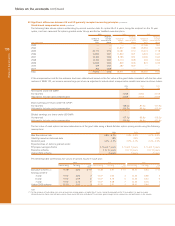RBS 2004 Annual Report Download - page 190
Download and view the complete annual report
Please find page 190 of the 2004 RBS annual report below. You can navigate through the pages in the report by either clicking on the pages listed below, or by using the keyword search tool below to find specific information within the annual report.
188
Notes on the accounts
Notes on the accounts continued
53 Significant differences between UK and US
generally accepted accounting principles (continued)
scheme assets compared with liabilities is recognised in
the balance sheet as an asset (surplus) or liability (deficit).
An asset is only recognised to the extent that the surplus
can be recovered through reduced contributions in the
future or through refunds from the scheme. US GAAP
requires a similar method but allows a certain portion of
actuarial gains and losses to be deferred and allocated in
equal amounts over the average remaining service lives of
current employees. A minimum additional liability must be
recognised if the accumulated benefit obligation (the
current value of accrued benefits without allowance for
future salary increases) exceeds the fair value of plan
assets and the Group has recorded a prepaid pension
costs or has an accrued liability that is less than the
unfunded accumulated benefit. Movements in the minimum
additional liability, together with the related deferred tax,
are recognised through other comprehensive income.
(h) Long-term assurance business
The shareholders’ interest in the long-term assurance fund
is valued as the discounted value of the cash flows
expected to be generated from in-force policies together
with net assets in excess of the statutory liabilities. Under
US GAAP, for traditional business, premiums are
recognised as revenue when due from the policyholders.
Costs of claims are recognised when insured events occur.
A liability for future policy benefits is established based
upon the present value of future benefits less the present
value of future net premiums. Acquisition costs for
traditional business contracts are charged to the profit and
loss account in proportion to premium revenue recognised.
For unit-linked business, premiums and front-end load-type
charges receivable from customers and acquisition costs
relating to the acquisition of new contracts are capitalised
and depreciated in proportion to the present value of
estimated gross profits. Costs of claims are recognised
when insured events occur.
(i) Extinguishment of liabilities
Under UK GAAP, recognition of a financial liability ceases
once any transfer of economic benefits to the creditor is no
longer likely. Under US GAAP, a financial liability is
derecognised only when the creditor is paid or the debtor
is legally released from being the primary obligator under
the liability, either judicially or by the creditor.
(j) Leasing
In accordance with UK GAAP, the Group’s accounting
policy for finance lease income receivable is to allocate
total gross earnings to accounting periods so as to give a
constant periodic rate of return on the net cash investment,
and certain operating lease assets are depreciated on a
reverse-annuity basis. Under US GAAP, finance lease
income is recognised so as to give a level rate of return on
the investment in the lease but without taking into account
the associated tax flows, and all operating lease assets are
depreciated on a straight-line basis.
(k) Securities
Under UK GAAP, the Group’s debt securities and equity
shares are classified as being held as investment
securities or for dealing purposes. Investment securities
are stated at cost less provision for any permanent
diminution in value. Premiums and discounts on dated debt
securities are amortised to interest income over the period
to maturity. Securities held for dealing purposes are carried
at fair value with changes in fair value recognised in the
profit and loss account. Under US GAAP, securities held by
the Group’s private equity business are considered to be
held by investment companies and are carried at fair value,
with changes in fair value being reflected in net income.
The Group’s other investment debt securities and
marketable investment equity shares are classified as
available-for-sale securities with unrealised gains and
losses reported in a separate component of equity, except
when the unrealised loss is considered other than
temporary in which case the loss is included in net income.
Under US GAAP, the Group recognises an other than
temporary impairment on an available-for-sale equity share
when its carrying value has exceeded its market value for
more than twelve months.
(l) Derivatives and hedging activities
SFAS 133 ‘Accounting for Derivative Instruments and
Hedging Activities’ was effective for the Group’s US GAAP
information from 1 January 2001. The Group has not made
changes in its use of non-trading derivatives to meet the
hedge criteria of SFAS 133. As a result, from 1 January
2001, for US GAAP purposes, the Group’s portfolio of non-
trading derivatives has been remeasured to fair value and
changes in fair value reflected in net income. Under UK
GAAP, these derivatives continue to be classified as non-
trading and accounted for in accordance with the underlying
transaction or transactions being hedged.
SFAS 133 does not permit a non-derivative financial
instrument to be designated as the hedging instrument in a
fair value hedge of the foreign exchange exposure of
available-for-sale securities.
SFAS 133 also requires derivatives embedded in other
financial instruments to be accounted for on a stand-alone
basis if they have economic characteristics and risks that
differ from those of the host instrument.
US GAAP does not permit a profit or loss to be recognised
on transacting a derivative unless its valuation is based on
observable market data. There is no similar requirement
under UK GAAP. Inception profits and losses reflecting the
application of the Group’s usual pricing methodologies are
recognised as they arise.
(m) Software development costs
Under UK GAAP, most software development costs are
written off as incurred. Under US GAAP, certain costs
relating to software developed for own use that are
incurred after 1 January 1999 are capitalised and
depreciated over the estimated useful life of the software.


